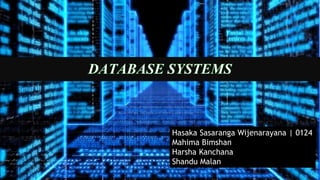
Database Fundamentals and Concepts Explained
- 1. Hasaka Sasaranga Wijenarayana | 0124 Mahima Bimshan Harsha Kanchana Shandu Malan
- 2. Content Data & Information What is a database? Data modeling Database Management System (DBMS) Data Manipulation Advantages & Disadvantages of DBMS
- 3. What is data? Raw facts and figures Can be numbers, characters, symbols, images etc. Meaningless
- 4. What is information The data that have been processed and organized in a presentable manner to make them meaningful and useful. Proper information must meets following criteria. Must be communicated to recipient Must be in a understandable language Must be organized properly Must be related to purpose
- 5. Data vs. Information Data Information Raw fact Data with context No context Processed data Just Numbers and text Value added to data -Summarized -Organized -Analyzed
- 6. What is a database? A collection of data organized in a manner that allows access, retrieval, and use of that data. Data is typically organized as “records” in a relation(table). Database is designed, built and populated with data for a specific purpose for a specific group of people. Allows to update.
- 8. What is Data Modelling? Process of creating a data model for the data to be stored in a Database. This data model is a conceptual representation of Data objects The associations between different data objects The rules. Emphasizes on what data is needed and how it should be organized instead of what operations need to be performed on the data.
- 10. Types of Data Models There are mainly three different types of data models: Conceptual: This Data Model defines WHAT the system contains. This model is typically created by Business stakeholders and Data Architects. The purpose is to organize, scope and define business concepts and rules. Logical: Defines HOW the system should be implemented regardless of the DBMS. This model is typically created by Data Architects and Business Analysts. The purpose is to developed technical map of rules and data structures. Physical: This Data Model describes HOW the system will be implemented using a specific DBMS system. This model is typically created by DBA and developers. The purpose is actual implementation of the database.
- 12. What is a DBMS? A software or a set of programs that provides the necessary infrastructure to developers/users to perform operations like selection, insertion, updation or deletion of data in a database.
- 13. DBMS Softwares Following are some popular DBMS softwares, MS-Access Oracle MySQL Dbase FoxPro
- 14. Database Design Conceptual database design : conceptual representation of the database, which has the identification of the important entities, relationships, and attributes. Logical database design : convert the conceptual representation to the logical structure of the database, which includes designing the relations. Physical database design : make a decision how the logical structure is to be physically implemented in the target Database Management System (DBMS)
- 15. Types of databases Relational database Distributed database Cloud database NoSQL database Object-oriented database Graph database
- 16. Relational Database A structure that allows us to identify and access data in relation to another piece of data in the database
- 17. Distributed Database A database that is logically the same system but it is physically spread over different sites of a computer network.
- 18. Cloud database A cloud database is a database service built and accessed through a cloud platform. Amazon Web Services Microsoft Azure SQL Database Cloud SQL by Google Oracle Database as a Service
- 19. Object-oriented database NoSQL, which stand for "not only SQL," is an alternative to traditional relational databases in which data is placed in tables and data schema is carefully designed before the database is built. OODB are databases that represent data in the form of objects and classes. In object- oriented terminology, an object is a real- world entity, and a class is a collection of objects. NoSQL database
- 20. Data Manipulation The process of changing data in an effort to make it easier to read or to make more organized. For example a log of data can be sorted out in alphabetical order making easier to locate. SQL (Structured Query Language) - standard computer language for relational database management and data manipulation
- 21. DML- Data Manipulation Language Sub language of SQL which enables users to access and manipulate data such as selection, insertion, deletion or modification. Keywords SELECT, INSERT, UPDATE, DELETE INSERT INTO table_name (column1, column2, column3,...columnN)] VALUES (value1, value2, value3,...valueN) SELECT * FROM table_name; UPDATE table_name SET column1 = value1, column2 = value2, ... WHERE condition; DELETE FROM table_name WHERE condition;
- 22. Advantages of a DBMS Controlling Data Redundancy: Data is recorded in only one place in the database and it is not duplicated. Data Consistency: Data item appears only once, and the updated value is immediately available to all users. Control Over Concurrency : In a computer file-based system in updating, one may overwrite the values recorded by the other. Backup and Recovery Procedures: automatically create the backup of data and restore data if required. Data Independence: Separation of data structure of database from application program that uses the data is called data independence.
- 23. Disadvantages of DBMS Cost of Hardware and Software: Processor with high speed of data processing and memory of large size is required. Cost of Data Conversion: Very difficult and costly method to convert data of data file into database. Cost of Staff Training: Time & cost for the training of staff to run the DBMS is high. Appointing Technical Staff: Trained technical persons such as database administrator, application programmers, data entry operators etc. are required to handle the DBMS. Database Damage: All data is integrated into a single database. If database is damaged due to electric failure or database is corrupted on the storage media, then your valuable data may be lost forever.
- 24. Thank You